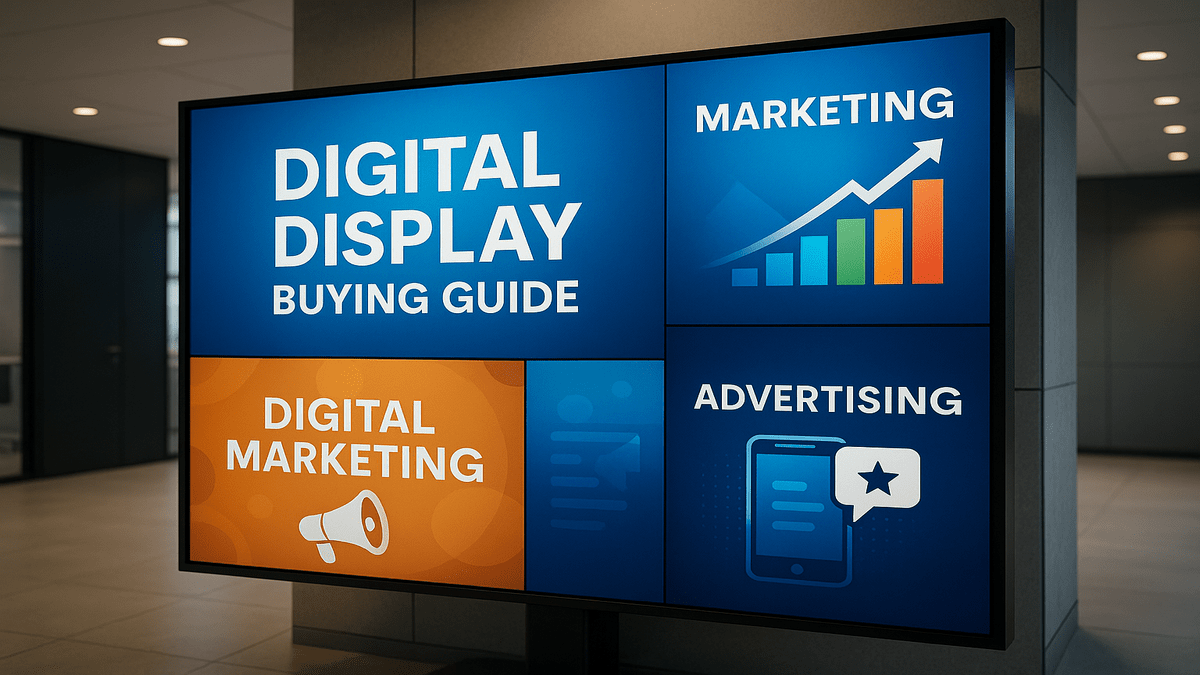In today’s fast-paced, visually driven world, digital displays have become a critical tool for businesses to communicate, engage, and influence their audiences. Whether you are in retail, hospitality, education, or corporate environments, having the right display can mean the difference between blending into the background and capturing customer attention. This Digital Display Buying Guide will walk you through the most important considerations before making a purchase, the questions you should be asking suppliers, and the pitfalls to avoid.
By the end, you’ll understand not only how to choose a digital display but also how to match your investment with your business goals. And if you’re in the market for the best digital displays for business, you’ll have a roadmap to make a confident decision.
What to Consider When Buying a Digital Display
Before diving into the specific features and technical specifications, it’s important to step back and look at the bigger picture. Buying a digital display isn’t just about picking the latest model or the largest screen, it’s about finding the perfect match between your business goals, your content strategy, and your budget.
In this Digital Display Buying Guide, we will explore 15 essential points you should consider before making your purchase. From understanding the purpose of your display and selecting the right location, to evaluating software compatibility and planning for future scalability, each step plays a critical role in ensuring you get the best value for your investment. By addressing these factors in advance, you can avoid common mistakes, maximize your ROI, and choose a display that serves your needs for years to come.
1. Start with Your Purpose
Before thinking about specs, prices, or brands, define the why behind your purchase. Ask yourself:
-
What do I want to achieve with this display?
-
Will it be used for promotions, branding, information sharing, or entertainment?
-
Is it intended for indoor or outdoor use?
Your purpose will dictate everything else — from the resolution and brightness you need to the type of mounting and software integration. A Digital Display Buying Guide is only effective if it starts with the end goal in mind.
2. Consider Location and Environment
One of the biggest factors influencing display choice is the environment. Indoor digital signage can get away with lower brightness levels and a wider variety of materials. Outdoor displays, however, require weatherproofing, higher brightness, and protection against vandalism.
There are also Challenges of installing outdoor digital displays that you must consider, such as power supply logistics, weather sealing, and compliance with local signage regulations. These can significantly impact both installation cost and long-term maintenance needs.
 3. Know Your Content Strategy
3. Know Your Content Strategy
A display is only as good as the content it delivers. If you’re planning high-definition videos, animations, or interactive experiences, you’ll need more powerful hardware and potentially higher refresh rates.
This is also where thinking about how to choose a digital display becomes critical. The design, size, and orientation of your display must work in harmony with your planned content format. For example, a menu board in a restaurant will have different requirements than a large-scale LED billboard in a stadium.
4. Screen Size and Resolution
Bigger isn’t always better. The right screen size depends on the viewing distance and the space available. Too small, and your message will be missed; too big, and it can overwhelm the viewer or the environment.
When evaluating resolution, remember that 4K isn’t necessary for every application. If your audience is far away from the display, a lower resolution can still look sharp and save costs.
5. Design for Impact
Content and hardware should work together to create an engaging experience. For brands seeking to stand out, following Important tips for designing a Digital Signage to attract customers can drastically improve viewer engagement. This includes choosing the right colors, animations, and call-to-action placements.
Good design ensures that your investment in hardware translates into results in customer interaction and sales.
 6. Durability and Maintenance
6. Durability and Maintenance
Digital displays are long-term investments. Look for build quality, manufacturer warranties, and easy access for repairs or part replacements.
Also, make sure you have a clear plan for upkeep. Tips for maintaining digital signage can save you from costly downtime and extend the lifespan of your investment. Cleaning schedules, software updates, and regular performance checks are just as important as the initial setup.
7. Budgeting and Total Cost of Ownership
While the initial purchase price is important, it’s only part of the financial picture. Factor in installation, software licenses, content creation, maintenance, and electricity consumption.
For businesses aiming to maximize ROI, the best digital displays for business are not necessarily the cheapest but the ones offering the best long-term value.
8. Software and Integration
Your digital display will likely need to connect with content management systems, analytics tools, or even interactive features like touchscreens and sensors. Ensure compatibility with your existing infrastructure.
Ask your vendor:
-
Is the software user-friendly?
-
Does it allow remote updates?
-
Can it schedule content automatically?
This part of the Digital Display Buying Guide is often overlooked, but software can make or break the usability of your investment.
9. Multi-Display and Video Wall Options
For large spaces or high-impact visuals, consider video walls. These can create immersive experiences and make your brand truly stand out. Learning How to Use Video Walls in Retail can help you understand how such installations drive customer engagement and create memorable shopping experiences.
10. Energy Efficiency and Sustainability
With growing awareness of energy consumption, it’s worth asking about eco-friendly features. Look for energy ratings, automatic brightness adjustments, and power-saving modes. Sustainable choices not only help the environment but also reduce operational costs.
11. Vendor Reputation and Support
Before finalizing your purchase, research the manufacturer and installer. Look for reviews, case studies, and after-sales support options.
When selecting the best digital displays for business, vendor reliability is just as important as the product itself. A great display without strong technical support can become a liability.
12. Questions to Ask Before Buying
Here are some critical questions that should be part of any Digital Display Buying Guide checklist:
-
What is the total cost of ownership?
-
How long is the warranty, and what does it cover?
-
Is the display suitable for 24/7 operation?
-
Can it handle the environmental conditions where it will be installed?
-
Is the software included, and what are the licensing terms?
-
What are the upgrade paths for hardware and software?
-
What kind of customer support is available post-purchase?
13. Planning for Future Growth
Technology changes quickly. Choose a display that can adapt to new formats, higher resolutions, or different content types. Scalability is especially important if you plan to expand your network of displays over time.
14. The Decision-Making Framework
When weighing your options, use this framework:
-
Purpose: What’s the goal of your display?
-
Location: Where will it be installed?
-
Content: What will be shown?
-
Budget: What’s your total cost of ownership?
-
Longevity: How long should it last before replacement?
-
Support: How reliable is the vendor’s service?
By applying this method, you can simplify how to choose a digital display and avoid decision fatigue.
15. Common Mistakes to Avoid
-
Choosing a display based solely on price
-
Ignoring environmental factors like sunlight or humidity
-
Overlooking the importance of maintenance
-
Buying without a clear content strategy
-
Not testing the display before committing to bulk purchases
Conclusion
Digital displays are powerful tools for modern communication, but only if chosen wisely. From understanding your goals to selecting the right size, resolution, and software, every decision counts. This Digital Display Buying Guide has walked you through the essential considerations and the right questions to ask, ensuring you can make a purchase that aligns with your vision and delivers measurable results.
Whether you’re searching for the best digital displays for business or trying to decide how to choose a digital display that fits your unique needs, remember that preparation is key. The right display will not only showcase your content but also strengthen your brand, engage your audience, and provide a return on investment for years to come.




